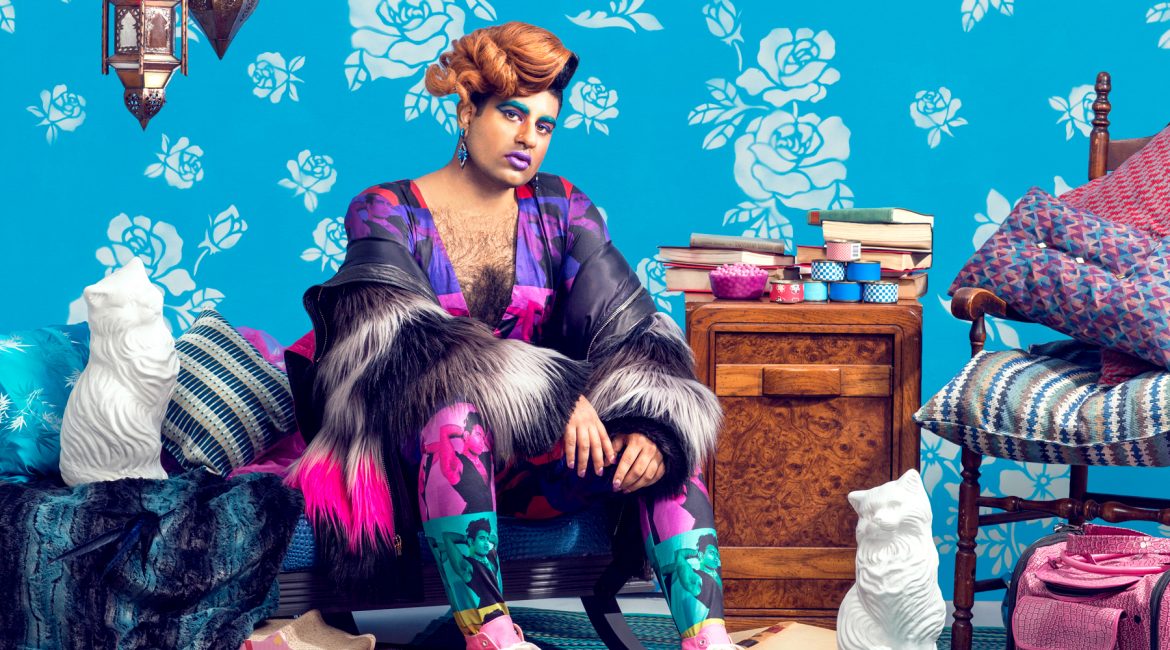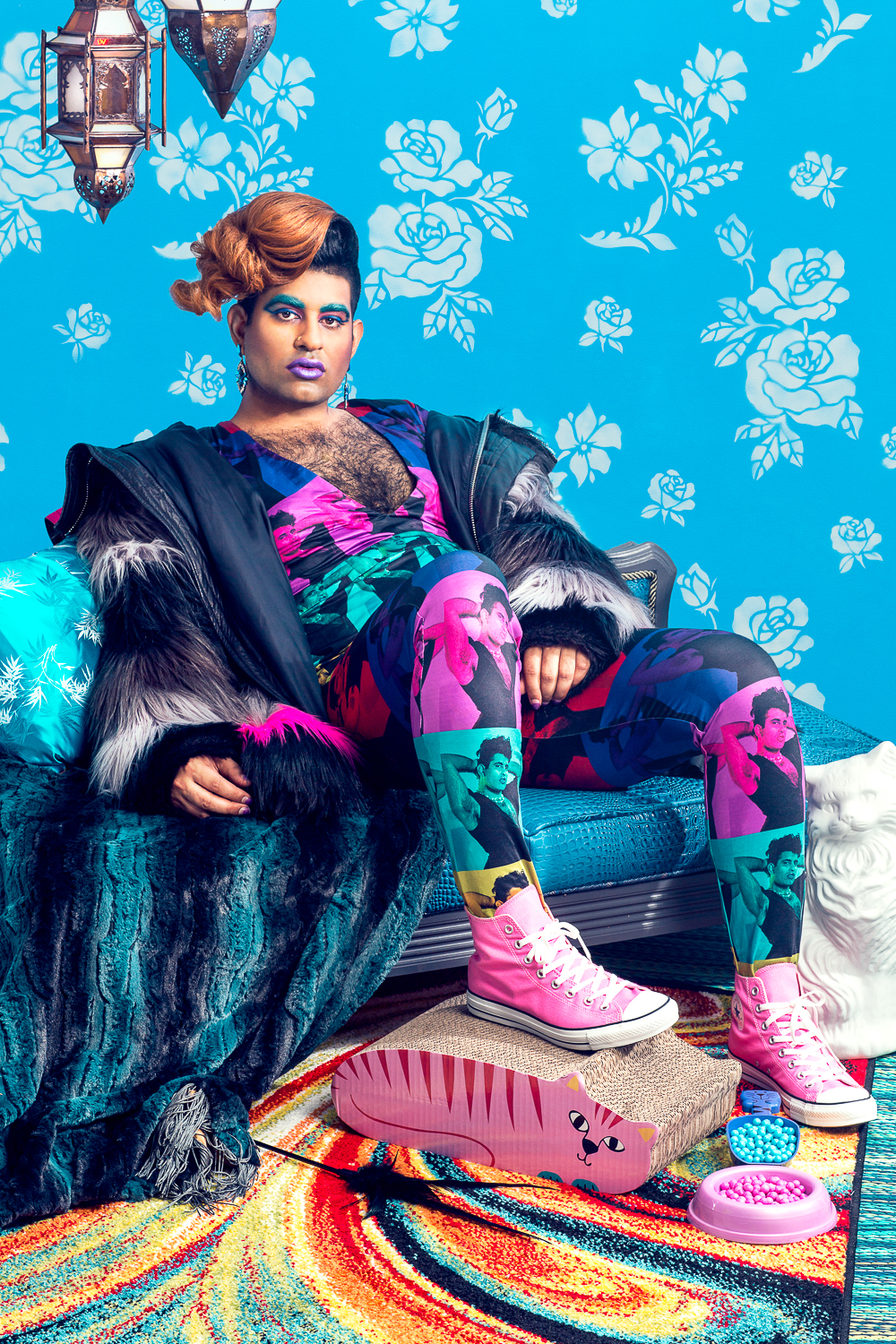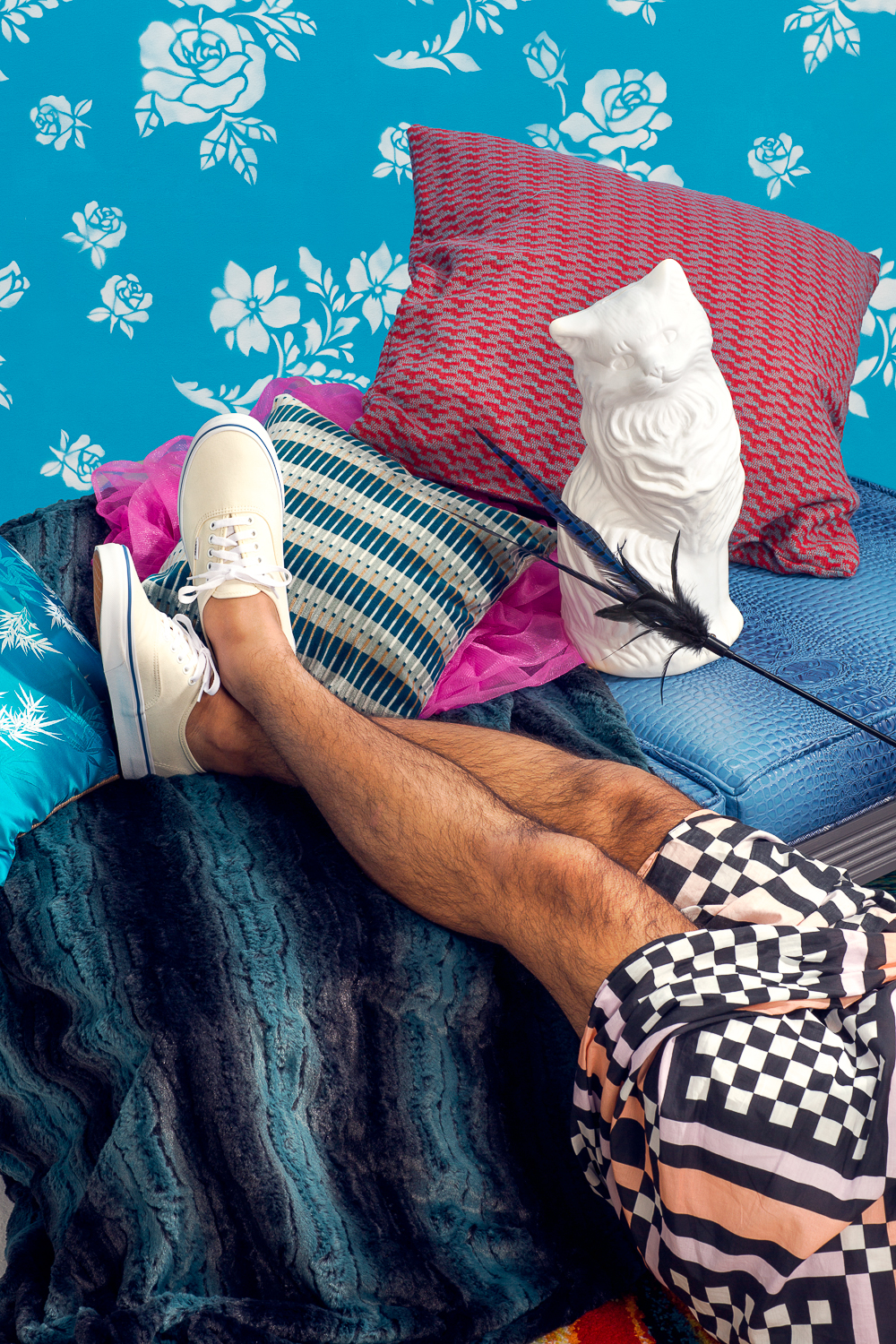Breaking though the gender binary, Alok Vaid-Menon (they/them pronouns) defies stereotypes on the daily. An internationally renowned poet, performance artist, educator, and activist, they are known for their keen political wit and wildly original personal style. Their work with DarkMatter, a trans South Asian performance art duo they founded with Janai Balasubramanian in 2013, has been showcased around the world. The youngest recipient of the Live Works Performance Act Award, Alok was also featured in the acclaimed HBO documentary, The Trans List (2016).
Layering traditional pieces with more contemporary silhouettes in vibrant colors, Alok challenges expectations of both gender and fashion. It’s a brilliant composite that the Posture team wanted to reflect in their set, which is why Creative Director Morgan Stuart chose to reimagine the Upper West Side apartment of a fabulous cat lady. To convey this, Nicky Ottav recreated a floral stencil pattern you generally see on wallpaper to make it larger and more colorful, and we filled the room with old books, reupholstered vintage furniture, and plastic cats. The scene paired perfectly with the bold lipstick, Dynasty-era blazers, and patterned dresses that are cornerstones of Alok’s fabulous transfeminine style.
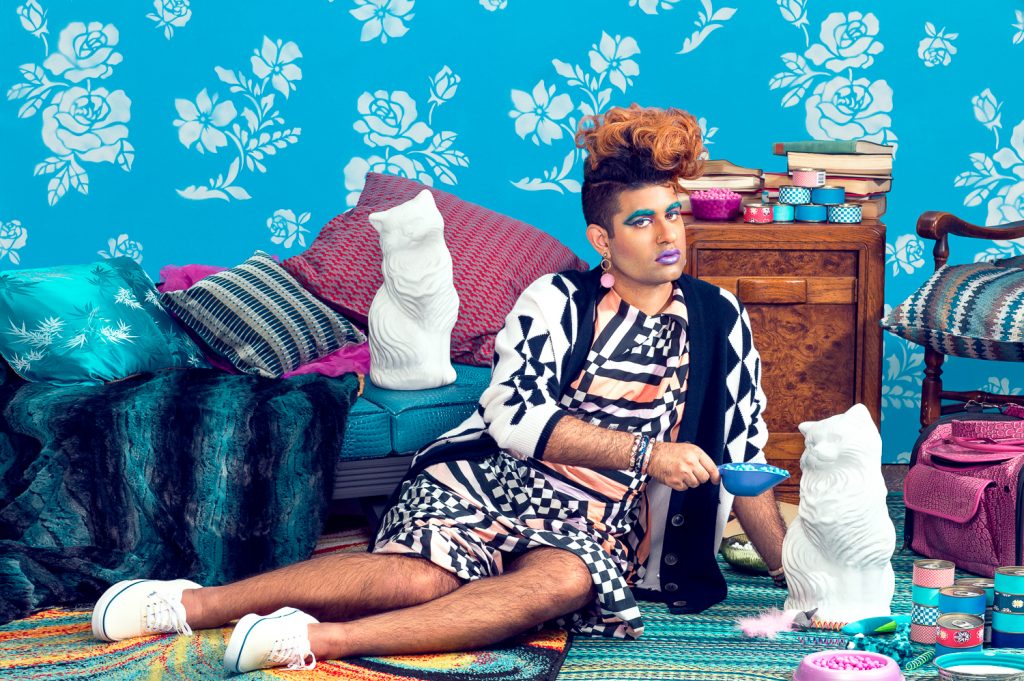
To start off, tell me a little bit about your style evolution. I assume a huge part of that’s intrinsically tied to your experience moving through gender?
Sure. I think for me, style has always been about politics. I didn’t get to control my race, or my gender, and all the stereotypes and assumptions that were made on the basis of that. So from a young age, I used clothing as a way to say, “there’s something more complicated going on here.”
Style is very much boxed into categories that I didn’t necessarily consent to. I’ve always been a bit of a fashionista — when I was four or five I was wearing socks to my knees, velcro sandals with dolphins, coordinated purple lunchbox, and short shorts. Style was how I began to understand myself as an individual, and eventually that allowed me to come to terms with my gender.
What were some of your early style influences as you started to carve out that space for yourself?
I really think cartoons are really great, and specifically cartoon villains. Cartoon villain style is so important to me, because I feel like that’s always been a space in popular imagination for queer and gender nonconforming people. Shoulders too big, arms too hairy, these fabulous monstrosities.
I also take a lot of cues from underground queer club culture, because I think that it really feeds contemporary fashion. It can be frustrating too, because a lot of what is now put on runways was first implemented on the bodies of drag queens, and club people, and queer people — many who were brutally harassed in the past because of it.
So it’s also really important to me, when I’m thinking about style and fashion, is to say, I actually feel like the current discourse about trans people starting to be recognized as models is misleading, ’cause we’ve always actually been the originators of the contemporary fashion industry. It’s just that our clothes made it, but not actually our bodies.
When was the first time that you wore lipstick? Do you remember that moment?
Oh gosh. When I was a little kid, I would wear my mom’s makeup, so probably five or six.
One of the things that stands out about your style is all the clashing — patterns and florals and the mix of everything going on. How did that develop for you, this idea of layering everything together?
In the same way that I don’t believe in gender, I don’t believe, there’s such a thing as clashing. I spent a lot of time researching fashion, and reading histories of aesthetics and textiles, I learned that so much of what we understand to be color coordination is actually part of a Western colonial machination. In India, we never had the same idea of prints having to align in a particular way, colors having to fit in a certain way. Whenever I’m back home in India, I see people clashing stuff all the time, and they don’t understand it as clashing. What I’m trying to do with my fashion is get people to ask questions. I want people to be confused, I want people to want to explore more, and I want people to consider a completely different worldview. The thing I don’t want is violence.
We all have different ways in which we “dress up.” What types of things do you like to wear that make you feel like the most powerful when you’re about to perform?
I first started to really dress the way I do now on stage, because that was the only place that I felt safe to do it, and to have fun with it. Why would I just reserve this for the stage? What makes me feel the most powerful is a good chunky heel.
Do you still rock sneakers?
I like pairing classic sneakers with flamboyant colors and prints. There is something delightful about that collision of old and new, simple and extravagant. The thing about classics like Chuck Taylors is that they are constantly able to be re-invented — it’s about pushing the image further and further. Their high tops are so versatile, I remember getting my first pair in middle school, and I still wear some today! The pink Converse are a favorite.
If you could dream up your ultimate sneaker, what would it be?
A white, platform sneaker that came with fun colorful markers for you to design it however you’d like!
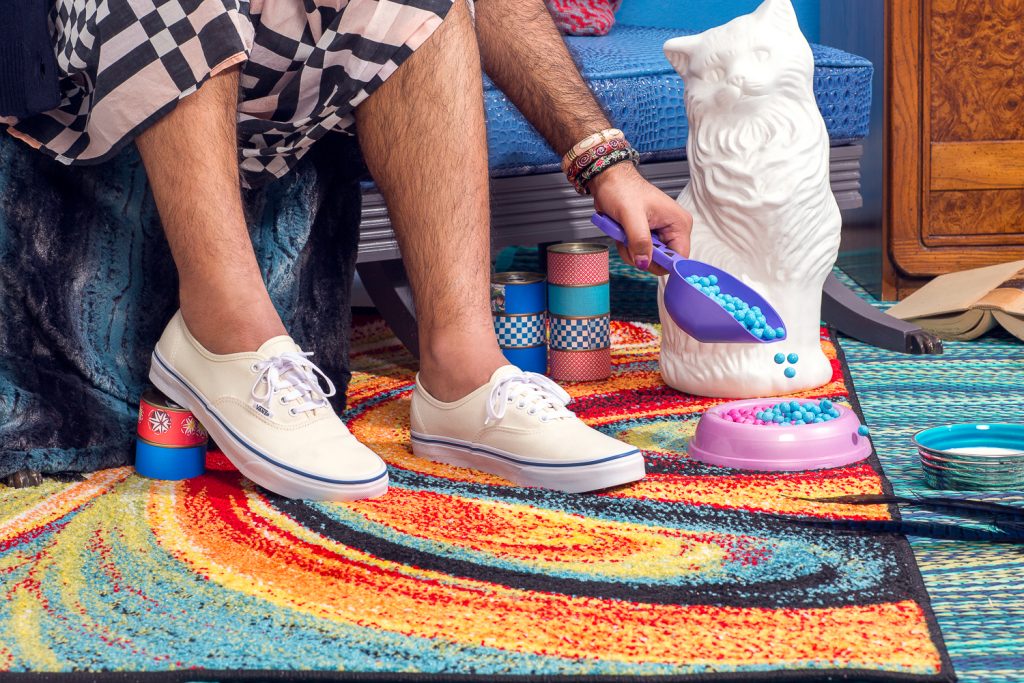
Tell us how you’d customize one of the pairs from the shoot! What would you write on it, or what would you do to it?
I would write some of my favorite quotes and lines of poetry by other trans artists. Their words are what give me the courage to keep on going!
What are some of your favorite places to shop?
I’m a secondhand kind of person. I actually love shopping in the South and the Midwest, my favorite place to shop in the world is Salt Lake City, Utah, for sure. I have a friend in Seattle a queer, femme, Black, Native woman, who started a new vintage line there called Indian Summer Vintage. I recently just collaborated with them in Seattle, and they curated a store with pieces of clothing that I would love.
What neighborhood in New York do you currently live in?
Oh, gosh, I’m moving around right now, but I really have a lot of love in my heart for the East Village and the Lower East Side, but both are just changing so much that it’s like simultaneous tons of love, but then also deep devastation every time I see another Duane Reade.
Who are your current style icons? Who is giving you some life right now?
There’s so many, but I’ll just shout out some of them. FAKA is a gender nonconforming, black, queer, performance duo from Johannesburg. Their aesthetic is incredible, I could spend hours scrolling down, being like, how are you real? I feel like trans people, especially trans people of color around the world, are my fashion icons, because we’re often having to be extra creative just to try to fit into clothes that were never made with us in mind, and create our own definitions of beauty.

How has social media, Instagram in particular, affected your life and your style?
It’s changed my life, I feel like #somillennial doing this. I think for me it’s been particularly unreal because growing up trans, I’ve saw absolutely no representation of myself or my body. Instagram is where I began to see myself visualized, and was able to develop a community digitally that I was unable to have as a young person. It’s really liberated me in so many ways — it makes you feel a lot less alone. It can sometimes feel like I’m the only trans person on the street, like everyone’s laughing at me — and then I can just turn on my phone, and in that moment I’m connected to other people going through the same stuff, and it feels like we’re all in this together.
Is there anything else, related to style, related to gender, that you’d like to say?
I’d like to say to other trans or gender nonconforming people out there: it’s all about you, baby. You shouldn’t feel pressured to have to look in any particular way — it’s whatever makes you feel most affirmed, comfortable, and beautiful.
For more information please visit The ONES.
Editorial Credits
Creative Director: Morgan T Stuart / @morgantstuart
Photographer: Bamby / @bambyofsuburbia
Senior Photo Director: Asher Torres / @ashertorresphotography
Photo Director: Ryan Bevans / @ryanbevans
Photo Assistant: Kimari Hazward / @kimarirh
Set Designer: Mo Pepin / @mostafapep
Muralist: Nicky Ottav / @nickyottav
Stylist: Shea Daspin / @sheadaspin
Hair: Britt White / @brittanwhite
Makeup: Katie Robinson / @misskatiepage using NARS Cosmetics @narsissist
Production Assts: Stevie Sullivan @ssulli.13 / Kyle Stuart @kvlestuart / Anabel Evans @anabelevans
Become a Posture Member
Join the Posture community and become an official member! By purchasing a membership, you will receive our special annual print edition ($20 value), free and/or discounted entry to all Posture events in NYC (including upcoming mixers, panel discussions, and networking opportunities), special offers from our partners, personal updates from the Posture team, and more. Learn more here.

